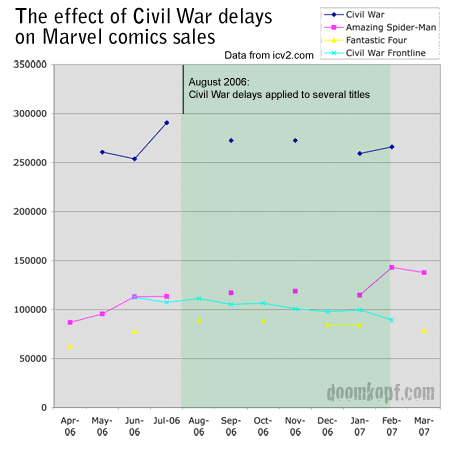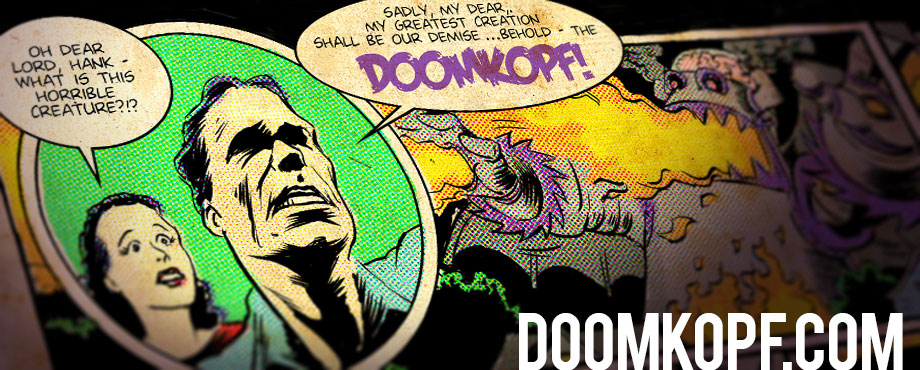A Difference of Opinion, Part 2
(feat. Marvel Executive Editor
Tom Brevoort)
This is the response to Part 1 of A Difference of Opinion.
I don’t think there is necessarily anything wrong with using fill-in artists to keep a book on schedule. So when DC announced they were going to use Carlos Pacheco to help J.G. Jones to meet Final Crisis deadlines, I can at least say I understand where they’re coming from; they don’t want to delay the book and they don’t want to delay the story. Fair enough.
 But just like I did two years ago, I disagree with the mentality, particularly in the case of something like Final Crisis. For big events, I think the visuals should be cohesive, because these big events will be looked back on and read as one whole. While Final Crisis, at least theoretically, ties in with the rest of the DC Universe in 2008, it is undoubtedly intended to be able to function as a self-contained story. When it is eventually released as a graphic novel, it won’t require an appendix of everything else DC was releasing at the time. It’s not as self-contained as something like Watchmen, but surely as self-contained as something like the original Crisis on Infinite Earths.
But just like I did two years ago, I disagree with the mentality, particularly in the case of something like Final Crisis. For big events, I think the visuals should be cohesive, because these big events will be looked back on and read as one whole. While Final Crisis, at least theoretically, ties in with the rest of the DC Universe in 2008, it is undoubtedly intended to be able to function as a self-contained story. When it is eventually released as a graphic novel, it won’t require an appendix of everything else DC was releasing at the time. It’s not as self-contained as something like Watchmen, but surely as self-contained as something like the original Crisis on Infinite Earths.
Publishers are aware of the increasing popularity of collected volumes, but using a fill-in artist to keep a book on schedule puts the priority on the monthly comics; delaying a monthly book to keep the creative team intact puts the priority on the art and the story, as nobody remembers the delays when they pull the graphic novel off the shelf. As I said in the comments a few days ago, the artist is much more than just a person who depicts what the writer is writing; the artist is part of the storytelling. Wanting to keep a commitment to the monthly buyers is completely understandable, but using a fill-in artist is just a short-term solution. Considering DC waited two years for its third Crisis after waiting 20 years for its second, however, the powers-that-be at DC are clearly no strangers to short-term planning.
I’m just a reader, though, so while that all makes sense to me, I asked Marvel Executive Editor Tom Brevoort what he thought now about his 2006 decision to delay Civil War, allowing Steve McNiven to remain the sole artistic voice on the book. With almost two years of hindsight, and with DC’s recent decision to use a fill-in on Final Crisis, I asked him if he would’ve decided any differently.
BREVOORT: The only thing we could possibly have done differently was to get started earlier–and that wasn’t an option.
That said, I thought and I think that we made the right decision in holding the line for Steve McNiven, and I believe history will prove this out. Certainly the demand for the Civil War collection is strong, and the reputation it’s gained as a quality piece of work will only make it more likely to remain a perennial seller over the years. And the strong sales we experienced on all of the tie-ins during and follow-up “Initiative”-bannered series afterwards would seem to bear this out.
At the end of the day, you do what you have to do; it’s not intrinsically wrong for DC to bring in fill-in guys on Final Crisis, that’s just a choice they make based on the needs of their publishing division. But I do think such a midway substitution is going to compromise the work in both the short and long term, and I’m very glad that Civil War was such a strong success that we were in a position to be able to hold the line, and bring the series to the intended conclusion with the intended creators.
I think that one of the things that’s going to hurt Infinite Crisis as a perennial work over time is the number of artists that had to be called in to finish it in a timely manner, no matter how many changes and improvements were made for the eventual collection. My educated guess is that it’s not going to hold up in the manner of the original Crisis [on Infinite Earths] over time, and won’t post such consistent and lasting sales. And depending on how the rest of Final Crisis comes together, the same may or may not be true of that series.
Carlos Pacheco is an outstanding artist, but he’s not what DC was selling on that series — he’s the extra hand that’s needed to get the book out on or close to schedule. But if what he does is consistent enough with the work J.G. Jones is doing and there’s no perceived drop in the quality of the book, it may work out all right. It’s more of a dice roll, but it may be what’s necessary for DC to meet its fiduciary responsibilities.
The case is often made that these delays are bad for business. Critics argue that these delays kill interest in stories. But a look at the actual sales, using Civil War as an example, shows that’s clearly not the case. Three ongoing series were affected by the delay imposed in August 2006 — Amazing Spider-Man, Fantastic Four and Civil War: Frontline.

As you can see in the above chart, there is little noticeable difference in the books’ sales after the delay was imposed; in the case of Fantastic Four, Amazing Spider-Man and Civil War: Frontline, sales actually increased after the delays. The overall arc of CW:FL sales stayed much more consistent than a typical miniseries run, even when being held back from its normal schedule.
So the argument that delays kill interest and hurt sales might make sense anecdotally, but factually, it simply doesn’t hold up.
There is still the argument that holding a title like Amazing Spider-Man or Fantastic Four translates to lost revenue, as that’s 100,000 comics or so that could have been sold that weren’t. The delay actually helped Fantastic Four come out two straight months in a row — that book couldn’t keep a monthly schedule for reasons completely unrelated to Civil War. That situation really only applies to Amazing Spider-Man, and any revenue lost there wasn’t noticed.
When Marvel announced which titles would be delayed that August of 2006, Newsarama contacted Mark Millar for comment, who said:
“This is a very cool thing for Marvel do to because it would have been so much easier to just go for a cheap fill-in artist instead of pushing back the books … Marvel really took a bullet here. This pushes a lot of cash into the next financial quarter for them and they’ve really put product over profit here.”
Company-wide, Marvel’s second and third quarters in 2006 were down slightly from the same period in 2005, but the stock price still went up as profit and revenue exceeded expectations. Analysts were expecting a bigger dip, and those expectations predated anything Steve McNiven did (or didn’t do) that summer — most of Marvel’s revenue these days comes from films, and 2006 saw only one movie (X-Men 3) hitting theaters. Even so, the stock saw a 70% increase over the year.
That cash that Marvel pushed into the next quarter left no trace. If there was any negative financial impact from delaying some comic books, it sure wasn’t noticed by any financial analysts.
Obviously, no one wants delays. If one has the option of starting early enough to avoid this situation, that’s clearly going to be best for everyone. But what it boils down to is this:
1. Delaying comics to keep the art team intact doesn’t affect fan interest in the main title or any tie-ins. The sample period analyzed during Marvel’s notorious Civil War delays shows sales increasing after the delay.
2. Delaying comics to keep the art team intact doesn’t result in noticeable lost revenue. Marvel’s revenue for those quarters exceeded expectations.
3. Delaying comics to keep the art team intact shows an immediate commitment to the storytelling team and a long-term commitment to the craft as a whole. It acknowledges the importance of a cohesive look when telling the story. It’s not a judgment or criticism against any potential fill-in artist; it’s an honor to all artists by respecting what they bring to the project.
Given that the only argument against delaying the book and supporting the use of fill-in artists is a short-term “I want my comics now,” it just seems obvious to me which is the most logical way to go. It’s not often that the best decision for art and creativity is also the best decision for business. When the needs of both of those categories overlap, you’ve clearly got a winner.

Checkmate.
I have to tell you that this doesn’t bother me too much, unless…
…the fill-in artist is shitty.
But on the whole I think that too big of a deal is made about artistic consistency. I agree that it’s jarring if you have somebody drawing in the DC house style, say, and then all of a sudden, I dunno…Bill Sienkiewicz takes over. But if it’s like George Perez doing the first few issues of INFINITY GAUNTLET and being relieved by Ron Lim, that’s okay.
“So the argument that delays kill interest and hurt sales might make sense anecdotally, but factually, it simply doesn’t hold up. ”
Yes, but the exact same can be said about whether a change in artists will hurt trade sales down the road. We won’t know for probably at least a decade whether Civil War’s trade sales will be better than Infinite Crisis or vice versa.
You make some good points Jim, but surprise surprise, I still feel it’s better to get these mega-events out on time. Of course the point of these posts wasn’t to convince each other, and it’s not like there’s really a “right” side to this issue.
Good read.
Here’s the thing, FFD — my argument isn’t based on trade sales being stronger. I never made that claim. It’s about the artistic whole being stronger, and I think that’s indisputable. My argument is if you can preserve the artistic whole and not hurt sales, why not do it?
And your answer is just that you don’t want to wait. You’ll compromise long-term value for something that’s not even short-term gain, since sales aren’t affected (and are arguably helped).
I guess I was more commenting on Tom Brevoort’s assurtion that Infinite Crisis won’t hold up as well over time.
And I’m not even sure I’m compromising long-term value. Like Justin said, substituting artists doesn’t really bother me as long as the new artist isn’t shitty and isn’t a huge departure from the established style. I once again have to point at Captain America as a shining example.
At Heroes Con, Mark Waid at one point started talking about how trades have affected comics production, and he made the point that his mindset going into creating a comic is completely different now, because he knows it will be preserved forever. And while that may make him push himself harder, it also leads to things like delays and a lack of spontaneity.
That’s an interesting perspective, and I think it helps show that it’s an issue with pros and cons on both sides, and there are right answers really only on a situational basis.
Oh wow. They killed the Human Torch. BIG DEAL. Didn’t they just KILL Captain America? They can still keep a Human Torch in the FF, bascuee if my memory is correct, the original Torch is still alive somewhere in the Marvel Universe. Even if he isn’t, they can always borrow one of the thousands out there in the alternate realities that the FF always visits. Hey he just showed up one day and what the heck, since we were already short one member we agreed to make him a part of the team! Or is that too original an idea?WHO CARES. This killing characters off for SHOCK value is getting old and stale. Anybody out there remember when they killed off Mister Fantastic and made Ant-Man part of the team? Or how about the time they killed off Doctor Doom and make Kristoff his replacement? THIS HAS BEEN DONE BEFORE AND DONE BETTER IN SOME CASES. Most often however, it (the story line) usually ends up being a major disappointment to the readers.All I can say is, this is one of the main reasons WHY I stopped buying monthly comics almost a decade ago. Certainly the biggest reson was the increasing cost of the comics themselves, but one of the biggest secondary reasons was that creators (writers/artists/editors) had pretty much ruined all my favorite characters or were writing comics that took all the enjoyment out of reading them.